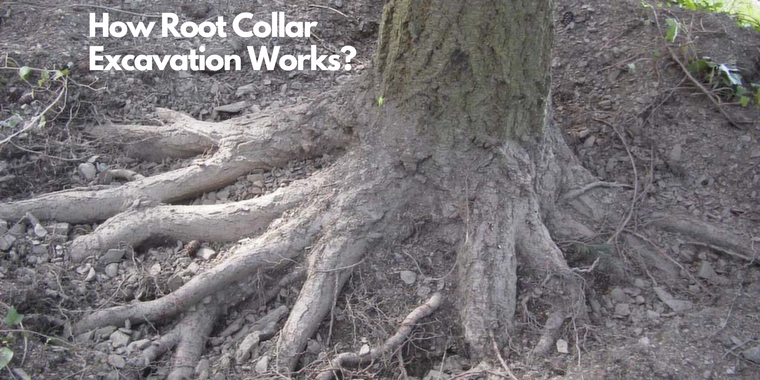
Root collar excavation is the most effective method of digging up stumps and roots left behind after removing an old tree or bush from your property. It’s used by landscapers and homeowners alike because it makes the job much faster and easier than the alternative methods of cutting, pulling, or burning stumps and roots, as well as more cost-effective in the long run. Here’s how root collar excavation works.
Click Here & Get up to 3 Quotes for Tree Care!
Why Should I Have My Roots Excavated?
We all know how important roots are for your yard and gardens. In order to get that ideal lawn, garden, or landscaping, you need deep and healthy roots. That is why you should have your root collar excavated by a professional. By removing small roots that surround the trunk of your tree, you can help cultivate great growth.
Without these little buggers getting in the way of each other, you will find it easier to water and maintain your prized vegetation. Taking care of those pesky tree root problems has never been easier or more affordable with Arborists Near Me! Let us know if we can be of service to you! Contact us now for a free quote!
What is Root Collar Excavation?
In order to better understand how to root collar excavation works, it's important to know what a root collar is. A root collar is exactly what it sounds like: an area of soil that surrounds a tree's main trunk (and its roots).
Root collars are generally about as wide as two adult arms outstretched and about one foot deep. A root collar may look like the solid ground at first glance, but there's actually plenty of nutrient-rich soil that can be disturbed by improper grading techniques or other landscape modifications.
What to do Before the Excavator Arrives
If you've ever had to hire an excavator to do some work on your property, then you know they aren't cheap. For example, a basic root collar excavation in Boston costs $550 per hour with a two-hour minimum.
While you may not always be able to plan ahead for excavator visits, there are steps you can take before they arrive so that it goes as smoothly as possible and is as cost-effective as possible. As mentioned above, getting permits for root collar excavation will keep your costs down. You can also call up different companies and get quotes from several of them before deciding who to hire.
Why Choose Us for Root Collar Excavation?
We’re a leading tree service directory online that prides itself on getting every job done with professionalism and expertise so every homeowner is confident they are hiring the right company. From root collar excavation to stump grinding and more, we offer affordable services with quick turnaround times to provide quality care for your trees. We’ve been helping people connect with tree service professionals and have built an excellent reputation for providing dependable service at reasonable prices. Whether you’re dealing with root collar excavation or need a tree removed,
Are There Other Ways to Deal with Tree Roots?
Have you ever tripped over a tree root? If so, you probably thought to yourself that trees have roots for a reason. While it's true that trees need their roots for stability and survival, there are instances when tree roots can be problematic.
Sometimes they grow into your lawn or garden area and make it impossible to keep your grass green or flowers blooming. They can also be damaging to buildings such as sidewalks and foundations of homes or businesses. In these situations, not only is tree root removal necessary; excavation is needed in order to properly remove them without causing more damage in your yard. Fortunately, there are ways around having to take out an entire tree when all you want is its root gone!
Can Trees Grow Through Grates?
A Simple Guide to Root Removal: Tree roots can damage sidewalks, driveways, and buildings. Fortunately, there’s a simple solution: root collar excavation. In some cases, even trees with large root systems can be saved—but you may need to do a little research before taking on your project.
The key is understanding how a tree's root system works, as well as it's needs for water and sunlight. To get started on your own project, follow these guidelines for carrying out an effective root collar excavation. First, make sure any roots present are confined to their natural area. If they aren't (you'll usually see them growing right through paving or grates), then remove those areas of pavement or grates and see if you can save the tree itself by pushing back new growth into its original location. Otherwise, make preparations for removal.
You'll want to dig at least 6 inches away from any visible roots so that when you pull up on it, none of its delicate root structure gets caught in cracks caused by removing too much ground cover; once it breaks off, it won't grow back!
What If the Trees in My Yard Need Special Treatment?
If you need to remove a few trees in your yard, there are plenty of ways to do it without compromising your landscaping or aesthetics. Root collar excavation is one of these ways. When you dig up a tree that has been planted for years, you should dig beyond its root ball and expose part of its root collar.
If it's not exposed, new grass or another tree won't grow in that spot because nutrients from nearby trees won't reach them easily. To get your landscaping back on track and avoid an unsightly bare patch where a tree once stood, follow these steps for digging around and exposing root collars during root collar excavation.
1. Register your company
2. Create a searchable listing
3. Connect with more clients
